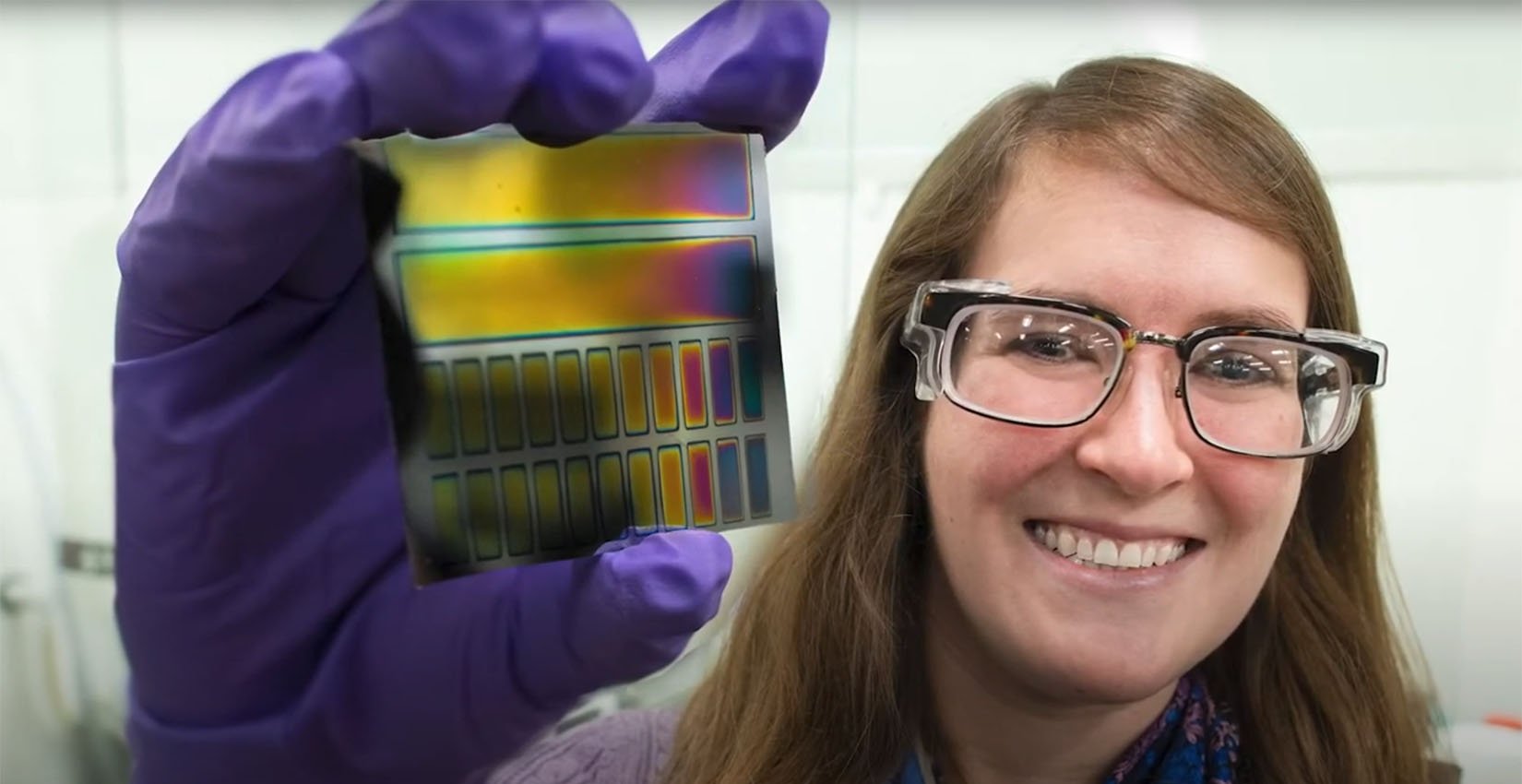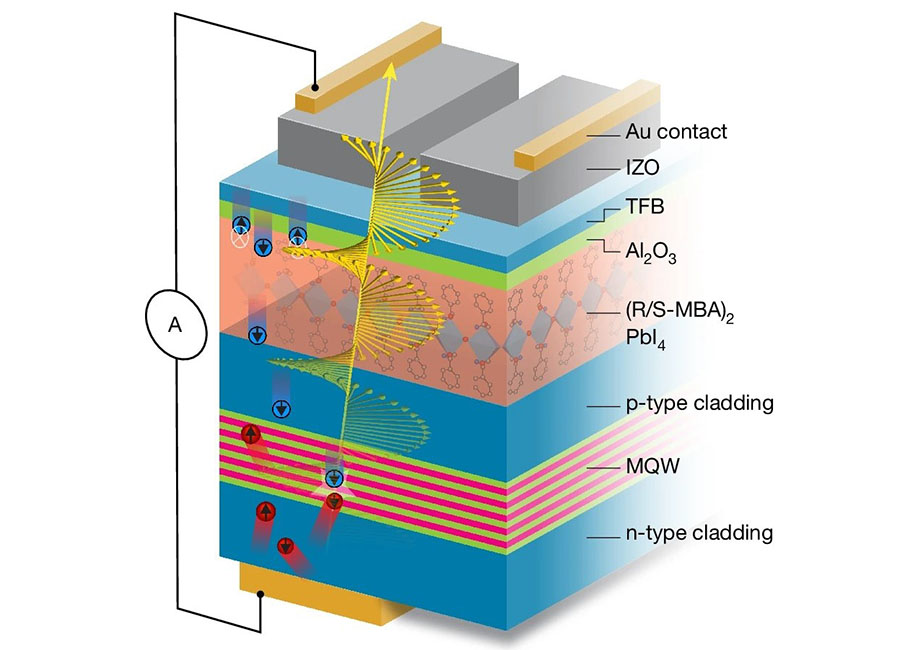Basic Energy Sciences
NREL's basic energy sciences programs aim to understand, predict, and ultimately control matter and energy at the electronic, atomic, and molecular levels.
Our research provides the foundations of new technologies for energy generation, conversion, transmission, storage, and use.

Funded by the U.S. Department of Energy (DOE) Office of Science, Basic Energy Sciences program, our research programs include core projects, Energy Frontier Research Centers, Energy Earthshot Research Centers, support for the Energy Innovation Hub Liquid Sunlight Alliance, and awards from DOE's Early Career Research Program.
NREL researchers develop foundations for clean energy solutions through core capabilities in semiconductors and materials science, nanomaterials synthesis and modification, synthesis and fabrication, photochemistry, electrochemistry, bioscience, theory, computation, and advanced spectroscopy.
These capabilities allow us to develop a better scientific understanding of photonic, electronic, atomic, molecular, nanoscale, semiconductor, and biological materials, systems, and processes.
Chemical Sciences, Geosciences, and Biosciences
NREL supports DOE's Basic Energy Sciences Chemical Sciences, Geosciences, and Biosciences Division through experimental, theoretical, and computational research to provide a fundamental understanding of chemical transformations and energy flow for the discovery of new chemical processes.
Solar photochemistry (Jeff Blackburn)
Photosynthetic energy transduction (Paul W. King)
Mechanism of photochemical nitrogen reduction (Paul W. King)
Questaal software suite: Hierarchical scalable Green's function modeling of chemistry at interfaces (Computational Chemical Sciences Center; Mark van Schilfgaarde)
Mechanistic determinants of flavin-based electron bifurcation (Early Career Award; Cara Lubner)
Cell-type specific pectins in plant cell walls (led by University of Georgia; Vivek Bharadwaj)
Beyond-density functional theory electrochemistry with accelerated and solvated techniques (Computational Chemical Sciences Center led by Rensselaer Polytechnic Institute; Derek Vigil Fowler).
Understanding interfacial phenomena for solar hydrogen production and nitrogen reduction (led by SLAC Accelerator National Laboratory; Todd Deutsch)
Materials Science and Engineering
NREL supports DOE's Basic Energy Sciences Materials Science and Engineering Division by fundamental experimental and theoretical research for the discovery and design of new materials with novel structures, functions, and properties.
Nitride materials and interfaces for radiation-hard integrated neutron detection (partially funded by the Advanced Scientific Computing Research program; Nancy Haegel)
Questaal software suite: Ab initio theory of unconventional superconductivity (Mark van Schilfgaarde)
Design, discovery, and chemical synthesis of earth abundant ferromagnetic nitrides (Sage Bauers)
Disorder in topological semimetals (Kirstin Alberi)
Kinetic synthesis of metastable nitrides (Early Career Award; Andriy Zakutayev)
Enabling durability in adsorbents for direct air capture (led by Lawrence Livermore National Laboratory; Wade Braunecker)
Formulation engineering of energy materials via multiscale learning spirals (led by Cornell University; David Moore)
Understanding interfacial phenomena for solar hydrogen production and nitrogen reduction (led by Dartmouth College; Sage Bauers)
Fundamental Studies of Hydrogen Arc Plasmas for High-Efficiency and Carbon-Free Steelmaking (Arizona State University-led; Hariswaran Sitaraman)
Featured Research
Learn more about NREL's basic energy sciences research.
Researchers Discover New Way To Make 'Atomic Lasagna'
Researchers discovered a method to transform materials with three-dimensional atomic structures into nearly two-dimensional structures—a
promising advancement in controlling their properties for chemical, quantum, and semiconducting applications.
Chemist Rebecca Smaha Knows It: Next-Gen Clean Energy Technologies Hinge on Basic Materials Science
Read the Q&A with NREL chemist Rebecca Smaha and her love of materials science.
Stronger Together: Coupling Excitons to Polaritons for Better Solar Cells and Higher Intensity LEDs
Researchers used transient absorption spectroscopy to demonstrate control of exciton/exciton annihilation,
which could help reduce energy dissipation and potentially increase efficiency in optoelectronic devices.
Innovative Materials and Scalable Manufacturing Pathways: New NREL Research Center to Look Toward the Future of Renewable Energy
Center will enable expanded materials selection and integration for next-gen power electronics through novel interface and substrate design, coupled with pathways to scalable, low-cost, high-speed manufacturing.
NREL Research Dives Deeper Into the Mysteries of Energy Control in Electron-Bifurcating Enzymes
Understanding the catalytic mechanism of this unusual class of enzymes may be a precursor to more efficient catalysis in the production of fuels and chemicals.
Understanding Bifurcating Enzymes Could Lead to More Efficient Renewable Fuel and Chemical Production
With support From DOE's Basic Energy Sciences program, NREL researchers unravel the atomic-level mysteries of flavin-based electron bifurcation.
New Database Aims To Accelerate Electrocatalyst Development Through Atomic-Scale Insights
Systematic approach provides baseline understanding of electrocatalytic reactions necessary for production of valuable fuels and chemicals.
Materials Science Software Enables High-Fidelity Answers to Basic Principles Questions
NREL's Questaal software helps simplify computationally intensive processes by solving quantum physics equations efficiently and with high fidelity.
Energy Frontier Research Centers
DOE Energy Frontier Research Centers (EFRCs) is a basic research program funded by DOE's Office of Basic Energy Sciences that brings bring together creative, multidisciplinary, and multi-institutional teams of researchers to address the toughest scientific challenges at the forefront of fundamental energy science research.
These centers use powerful new tools for characterizing, understanding, modeling, and manipulating matter from atomic to macroscopic length scales. They also train the next-generation scientific workforce by attracting talented students and postdoctoral researchers interested in energy science.
NREL leads two and participates in six EFRCs:

NREL leads the Center for Hybrid Organic-Inorganic Semiconductors for Energy EFRC.
NREL EFRC Director: Matt Beard

NREL leads A Center for Power Electronics Materials and Manufacturing Explorations EFRC.
NREL EFRC Director: Nancy Haegel

NREL participates in the Bioinspired Light-Escalated Chemistry EFRC.
NREL Principal Investigator: Garry Rumbles

NREL participates in the Center for Alkaline-based Energy Solutions EFRC.
NREL Principal Investigator: Bryan Pivovar

NREL participates in the Center for Electrochemical Dynamics and Reactions on Surfaces EFRC.
NREL Principal Investigator: Myles Steiner

NREL participates in the Ensembles of Photosynthetic Nanoreactors EFRC.
NREL Principal Investigator: Katie Hurst

NREL participates in the Reconfigurable Electronic Materials Inspired by Nonlinear Neuron Dynamics EFRC.
NREL Principal Investigator: Andrew Ferguson

NREL participates in the Center for Soft PhotoElectroChemical Systems EFRC.
NREL Principal Investigator: Elisa Miller
Previously, NREL led the Center for Next Generation Materials Design and the Center for Inverse Design. NREL participated in these EFRCs:
Biological Electron Transfer and Catalysis
Center for Advanced Solar Photophysics
Center for Direct Catalytic Conversion of Biomass to Biofuels
Center for Interface Science: Solar Electric Materials
Center for Energy Efficient Materials
Molecularly Engineered Energy Materials.
Energy Earthshot Research Centers
DOE Energy Earthshot Research Centers (EERCs) bring together multi-investigator, multi-disciplinary teams to address key basic research challenges relevant to applied R&D activities to help realize Earthshot stretch goals identified by the Energy Earthshots™ initiative.
EERCs receive support from three primary DOE Office of Science programs—Advanced Scientific Computing Research, Basic Energy Sciences, and Biological and Environmental Research. Each EERC is guided by a DOE national laboratory with partners across the United States from academia and industry. NREL leads two EERCs:
DEGREES: Degradation Reactions in Electrothermal Energy Storage
Advances the fundamental understanding of degradation mechanisms in thermal energy storage materials for grid-scale, long-duration energy storage technologies
FLOWMAS: Floating Offshore Wind Modeling and Simulation
Delivers the fundamental research necessary for a 70% levelized cost reduction of floating offshore wind by 2035
Fuels From Sunlight Energy Innovation Hub
DOE's Basic Energy Sciences program manages the Energy Innovation Hubs, which focus on collaborative fundamental science research with the intent to demonstrate and evaluate integrated energy systems.
NREL is part of the Liquid Sunlight Alliance (LiSA), a Fuels from Sunlight Energy Innovation Hub focused on research for generation of liquid fuels from sunlight, water, carbon dioxide, and nitrogen. Watch the video about LiSA research at NREL.

Contact
Share
Last Updated March 25, 2025



